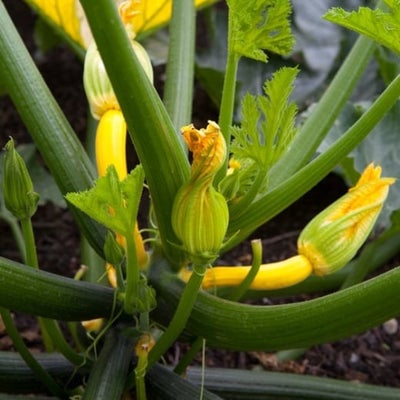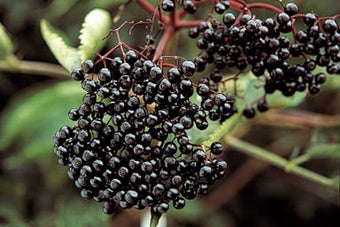
Quick facts
Suitable for - basil, borage, chives, courgette, day lily, hibiscus, hollyhocks, scented geraniums, peas, rocket, roses, sunflower, violas and more
Timing - Spring to autumn
Difficulty - Easy
Practical considerations
When collecting flowers for eating, keep the following in mind;
- Accurate identification of flowers is essential – if you are in doubt, don’t eat
- Pick young flowers and on dry mornings, before the sun becomes too strong, so the colour and flavours will be intense
- Use flowers immediately for best results or refrigerate in a plastic bag for a couple of days. Dried or frozen flowers are best used in infusions or cooked
- Generally, only the petals are used, so discard stamens, pistils and calyces of large flowers like hollyhocks, roses, lilies and hibiscus. For some flowers it's worth removing the bitter ‘heel’ at the base of the petal
- Petals of daisies, borage and primroses can easily be separated from the calyx
- Smaller flowers in umbels like fennel and dill can be cut off and used whole
Sowing Edible Flowers
Edible flowers from your garden
Home-grown flowers, free from and soiling by dogs and other pets are best. Many of the plants listed here as having edible flowers are widely offered for sale. However, unless they're labelled for ‘culinary purposes', grow them on for at least three months to reduce the risk of residues, and only harvest subsequent flowerings. Many garden favourites are edible and a few are listed below:
Alpine pinks (Dianthus) – a clove-like flavour ideal for adding to cakes as flavoured sugar, oils and vinegars
Bergamot (Monarda didyma) – a strong spicy scent, makes good tea and complements bacon, poultry, rice and pasta
Chrysanthemum (Chrysanthemum) – petals flavour and colour creamy soups, fish chowder and egg dishes in the same way as calendula
Daisy (Bellis perennis) – not a strong flavour but petals make an interesting garnish for cakes and salads
Day lily (Hemerocallis) – add and flowers to stir fries, salads and soups. Crunchy with a peppery aftertaste but may have a laxative effect. Avoid buds damaged by gall midge
Elderflower (Sambucus nigra) – used to make wine and cordials, or place in a muslin bag to flavour tarts and jellies, remove before serving. Elderflowers can be dipped in batter and deep fried
Hibiscus (H. rosa-sinensis) – refreshing citrus-flavoured tea, enhanced by rosemary
Hollyhock (Alcea rosea) – remove all traces of pollen and decorate cakes with crystallized petals
Lavender (Lavandula augustifolia) – flavoured sugar, honey or vinegar can be used to in cakes and biscuits while sprigs compliment roast pork, lamb and chicken
Nasturtium (Tropaeolum majus) – brightly-coloured, peppery flowers are good in salads and pasta dishes. The whole flower, leaves, and buds can be used or just the petals for a milder flavour
Pot marigold (Calendula officinalis) – intense colour and a peppery taste useful in soups, stews and puddings. Petals can be dried or pickled in vinegar or added to oil or butter
Primrose (Primula vulgaris) – decorate cakes with crystallized or fresh primrose or cowslip flowers. They can be frozen in ice cubes
Rose (Rosa) – all roses are edible with the more fragrant roses being the best. Petals can be crystallized, used to flavour drinks, sugar and even icing for summer cakes
Scented geraniums (Pelagonium) – flowers are milder than leaves and can be crystallized or frozen in ice cubes for summer cordials
Sunflower (Helianthus annuus) – blanch whole buds and serve with garlic butter. Petals can be used in salads or stir fries
Sweet violet (Viola odorata) – delicate flavour, suitable for sweet or savoury dishes as well as tea. Use candied violets and pansies as a garnish on cakes and soufflés
Tiger lily (Lilium leucanthemum var. tigrinum) – delicate fragrance and flavour enhances salads, omelettes and poultry, plus can be used to stuff fish
Edible flowers from your vegetable patch and herb garden
Herb flowers like basil, chives, lavender, mint, rosemary and thyme impart a more subtle flavour to food than the leaves.
Borage (Borago offincinalis) – the cucumber flavour of these attractive blue flowers adds interest to cakes, salads and pate. Flowers are easily removed and can be frozen in ice cubes or crystallized
Basil (Ocimum basilicum) – sweet, clove-like flavour compliments tomato dishes as well as oils, salad dressings and soups. Use aromatic leaves of both green and purple in Mediterranean dishes
Dill (Anethum graveolens) – aniseed flavour, ideal addition to salads, vegetables and fish dishes. Add flowers to mayonnaise, white sauce and pickles
Chives (Allium schoenoprasum) – mild onion flavour, good in salads, egg dishes and sauces for fish
Clover (Trifolium pratense) – both red and white clover flowers can be used to garnish fruit and green salads or make wine from whole red flowers
Courgette or marrow flowers (Cucurbita cvs) – can be eaten hot in a tomato sauce or cold stuffed with cooked rice, cheese, nuts or meat. Use male flowers so as not to reduce yield (unless you're suffering from a glut!)
Fennel (Foeniculum vulgare) – all parts are edible and enhance salmon, pâtés and salads. Flowers preserved in vinegar can be used in winter
Garden pea (Pisum sativum) – add flowers and young shoots to salad for a fresh pea taste
Mint (Menthaspp) – apple, pineapple and ginger mint, plus peppermint and spearmint flowers can all be used in vinegar and butter for both sweet and savoury dishes
Pumpkins and squashes (Cucurbita cvs)– pick male flowers once the females are pollinated. Use in the same way as courgette flowers.
Rosemary (Salvia [formerly Rosmarinus] officinalis) – a sweet flavour similar to the leaves can be used fresh to garnish salads and tomato dishes or to flavour butter
Salad rocket (Eruca vescaria) – adds peppery flavour to salads
Problems
Correct identification is important. If in any doubt do not eat. RHS members can contact RHS Gardening Advice for help with identification.
Other things to take into consideration include:
- Avoid old, faded or dusty flowers from roadsides and areas frequented by livestock or dog walkers
- Beware of bees and remove small insects from flowers by giving them a shake to encourage bigger insects to leave, then dipping them in a bowl of cold salt water and dry on paper towel
- People susceptible to allergy, especially pollen, should not eat flowers
- Insects and diseases are best dealt with by cutting back and encouraging regrowth as no are specifically approved for use by home gardeners on edible flowers



